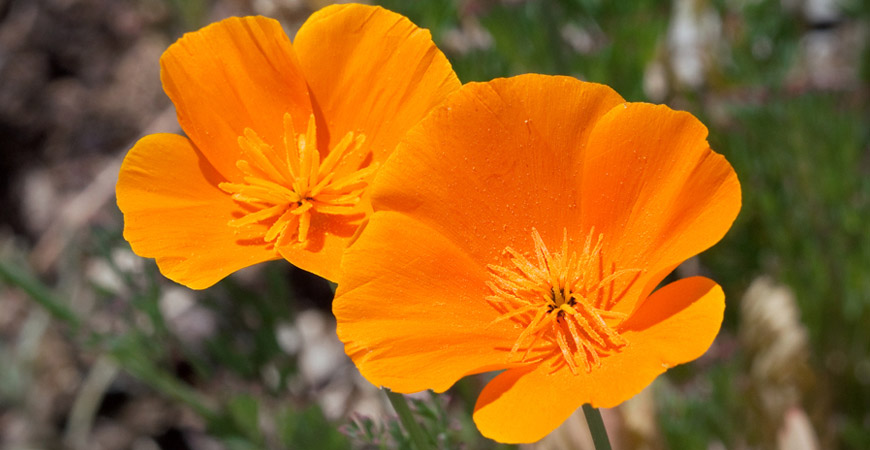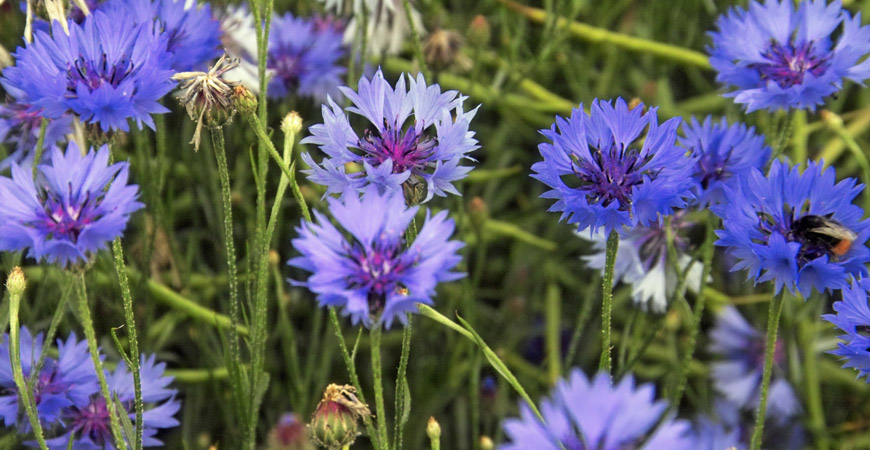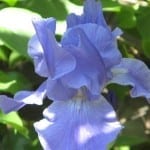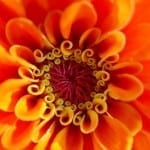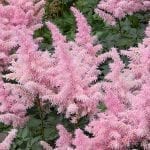
Plant These 5 Annual Flowers This Fall, and Enjoy a Beautiful Spring!
If you do any gardening, you’ve heard of certain food crops and perennial flower bulbs that are ideal for fall planting. But did you know that some self-seeding annual flowers are also perfect for planting this time of year?
You read right–even if you live in one of old Jack Frost’s favorite stomping grounds, you can still plant these annual flowers this fall and get a head start on next year’s blooming season. It’s easy to do, and the rewards are gorgeous!
Read on to find out about 5 annual flowers that you can plant this fall.
1. Annual Flowers: Johnny Jump-Up (Viola tricolor)
Johnny jump-up, also called heartsease or field pansy is a colorful member of the violet family. Its flowers are smaller than its cousin the pansy, but what it lacks in size, it makes up for in abundance and color.
Johnny jump-up produces large numbers of tri-color blooms that are usually yellow, purple, and white, but can also include an apricot shade. This flower gets its name because of its enthusiastic self-seeding, which makes it seem to “jump up” on its own.
Johnny jump-up thrives in partially shaded areas, as well as in the full sun, and does well in USDA Hardiness Zones 4a to 9a.
Not only is Johnny jump-up a hardy, colorful flower; it’s also edible. Edible flowers can add style and panache to desserts, salads and hors d’oeuvres, and are excellent for dinner parties and special occasions.
Just be sure not to spray any pesticides or other chemicals on your Johnny jump-ups. Especially if you plan to feature them on the dinner table.
2. California Poppies (Eschscholzia californica)
California poppies, also called Thai silk, are breathtakingly beautiful. Their striking blooms are medium to large in size, with silky, crepe-paper petals that can be pink, red, yellow, or orange (see photo).
This very adaptable flower thrives in dry or moist ground, and boasts foliage that can be silvery or even bluish, and is nearly as eye-catching as the blooms themselves. California poppies enjoy an extended blooming season in USDA Hardiness Zones 9a and above, which includes much of the Southeast, Southwest and West Coast.
California poppies will wow you and your neighbors as border flowers, groupings, or container plants. They also make beautiful cut bouquets, so you can enjoy a little of your garden indoors.
3. Cornflowers (Centaurea cyanus)
Cornflowers, also called blue bottles or bachelor’s buttons, can come with lavender, pink, purple or white flowers. What they’re best known for, though, is the striking blue blooms that give the color “cornflower blue” its name.
Blue is one of the more difficult-to-find bloom colors, and cornflowers will add a vibrant splash of blue to your garden.
These very adaptable flowers grow quickly and do well in dry or moist soil, and in partially shady areas or full-sun zones. They are so adaptable, in fact, that they can sometimes become invasive, so be prepared to keep these boisterous blooms in their place, or to have lots of cornflowers.
Cornflowers make good cut flower arrangements or dried flowers.
4. Flowering Tobacco (Nicotiana alata)
Flowering tobacco, also called nicotania, jasmine tobacco, or ornamental tobacco, has small, star-shaped blooms that come in pink or white. This adaptable, slow-growing flower thrives in partial shade or full sun, and prefers well-drained soil.
It makes a lovely border or container plant, and also makes attractive garden groupings.
Flowering tobacco’s star-shaped blooms are not only attractive to the human eye; they also attract butterflies and hummingbirds. This makes them ideal for planting near a window or other visible area.
It’s easy for you and your family can enjoy the beautiful visitors these blooms will bring to your garden. Flowering tobacco’s blooms are also fragrant, so they please more than just one of your senses.
But keep pets and small children out of the flower bed: Like many plants, flowering tobacco is poisonous if ingested.
5. Feverfew (Tanacetum parthenium)
Feverfew, also called matricaria, is an attractive annual that produces clusters of small, daisy-like flowers that can be yellow or white. It thrives in USDA Hardiness Zones 5a through 8a, requires full sunlight to grow well, and you can plant it in dry or moist soil.
Its flowers have a lovely fragrance, and are well suited for use in cut flower arrangements and as dried flowers. Its lacy green leaves are also quite attractive.
Besides adding beauty to your garden, feverfew is also a favorite herbal remedy for many people. The ancient Greeks used it to reduce fevers, which is how it got its name. Although modern studies have shown that it is not effective as a fever reducer.
Nowadays, feverfew is mostly used to treat and prevent migraine headaches. While all of the above-ground parts of the feverfew plant are edible, herbalists generally use dried feverfew leaves to treat headaches.
As with any herbal remedy, talk to your doctor before using feverfew to treat a medical condition. Don’t spray feverfew with pesticide or any other chemical if you plan to ingest it.
Fall Planting of Annual Flowers
Planting these hardy annual flowers in the fall is a pretty simple process. Their high adaptability makes their seeds able to lie dormant under the ground during cold weather. They will be ready to put on a colorful show when warmer weather arrives.
Organic Gardening Magazine offers this easy guide for planting these 5 flowers this fall.
(Photos By David Wright, Carl E Lewis, Zeynel Cebeci)

